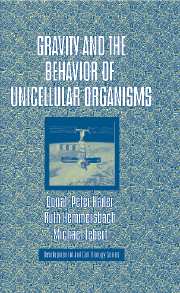Book contents
- Frontmatter
- Contents
- List of Abbreviations
- Preface
- 1 Introduction
- 2 Methods in Gravitational Biology
- 3 Image Analysis
- 4 Ciliates
- 5 Flagellates
- 6 Other Organisms
- 7 Responses to Other Stimuli
- 8 Energetics
- 9 Models for Graviperception
- 10 Evolutionary Aspects of Gravisensing: From Bacteria to Men
- 11 Perspectives
- References
- Index
5 - Flagellates
Published online by Cambridge University Press: 18 August 2009
- Frontmatter
- Contents
- List of Abbreviations
- Preface
- 1 Introduction
- 2 Methods in Gravitational Biology
- 3 Image Analysis
- 4 Ciliates
- 5 Flagellates
- 6 Other Organisms
- 7 Responses to Other Stimuli
- 8 Energetics
- 9 Models for Graviperception
- 10 Evolutionary Aspects of Gravisensing: From Bacteria to Men
- 11 Perspectives
- References
- Index
Summary
Many photosynthetic or heterotrophic flagellates from various taxonomic origins investigated so far have been found to be capable of gravitactic orientation and to orient themselves in the water column by positive, negative, or transversal gravitaxis. Two species can be regarded as model systems, Chlamydomonas and Euglena, since in these organisms gravitaxis has been studied in more detail. Earlier hypotheses assumed that gravitactic orientation is mediated by a buoy effect, where the cell is tail-heavy, and the flagellum — emerging from the anterior end — pulls the organism upward. A number of observations are in contradiction to this model. Rather, at least in Euglena, an active, physiological graviperception mechanism seems to be responsible for the observed orientation. For this organism, the whole cell body is assumed to function as a statolith and exert pressure on the lower membrane. This force is thought to activate mechanosensitive calcium ion channels. During each rotation around its long axis, more calcium enters the cell until a concentration threshold is reached — upon which the flagellum swings out and induces a course correction. Other elements of the sensory transduction chain include changes in the membrane potential, cAMP as secondary messenger, and possibly additional elements. In Euglena and other flagellates, gravitaxis is controlled by an endogenous rhythm that also affects the cell form, cAMP concentration, and other physiological parameters.
- Type
- Chapter
- Information
- Gravity and the Behavior of Unicellular Organisms , pp. 75 - 105Publisher: Cambridge University PressPrint publication year: 2005

